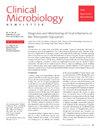人类疱疹病毒6感染与诊断
Q3 Medicine
引用次数: 1
摘要
人类疱疹病毒6 (HHV-6)在儿童早期引起原发性感染,并在其宿主中建立终身潜伏期。HHV-6的再激活,特别是在免疫抑制患者中,与各种临床并发症有关。由于该病毒的高流行率和难以区分潜伏感染和急性感染,急性HHV-6感染的诊断一直是一项重大挑战。HHV-6的染色体整合也会进一步使HHV-6疾病的管理和诊断复杂化。基于pcr的方法已成为HHV-6诊断的主要方法,然而,在临床疾病背景下对结果的解释至关重要。本文章由计算机程序翻译,如有差异,请以英文原文为准。
Human Herpesvirus 6 Infection and Diagnostics
Human herpesvirus 6 (HHV-6) causes primary infection in early childhood and establishes lifelong latency in its host. Reactivation of HHV-6, especially in immunosuppressed patients, has been associated with a variety of clinical complications. Diagnosis of acute HHV-6 infection has been a major challenge due to high prevalence of the virus and the difficulty in distinguishing latent infections from acute. Chromosomal integration of HHV-6 also occurs further complicating the management and diagnostics of HHV-6 disease. PCR-based methods have become the mainstay of HHV-6 diagnostics, however, interpretation of results in the context of clinical disease is of utmost importance.
求助全文
通过发布文献求助,成功后即可免费获取论文全文。
去求助
来源期刊

Clinical Microbiology Newsletter
Medicine-Infectious Diseases
CiteScore
2.20
自引率
0.00%
发文量
35
审稿时长
53 days
期刊介绍:
Highly respected for its ability to keep pace with advances in this fast moving field, Clinical Microbiology Newsletter has quickly become a “benchmark” for anyone in the lab. Twice a month the newsletter reports on changes that affect your work, ranging from articles on new diagnostic techniques, to surveys of how readers handle blood cultures, to editorials questioning common procedures and suggesting new ones.
 求助内容:
求助内容: 应助结果提醒方式:
应助结果提醒方式:


